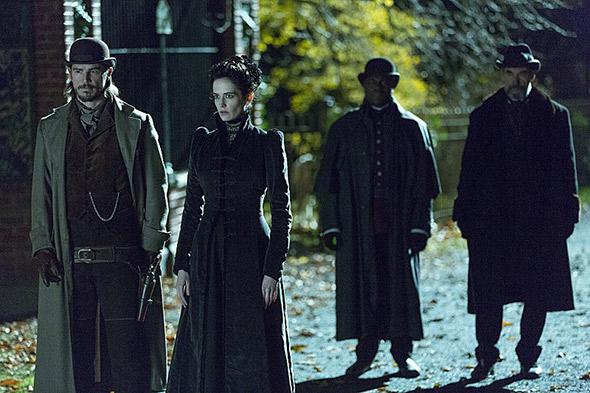How much more is there to say about vampires? This question hangs over Showtime’s new Gothic horror series Penny Dreadful, which begins on Sunday night. A kind of high-minded, Grand Guignol monster mashup, screenwriter John Logan’s series features not just vampires, but serial killers, seers, and immortal beings, all running around 1890s London. Dr. Frankenstein (Harry Treadaway) and his creation rub shoulders with Dorian Gray (Reeve Carney). Other characters seem assembled, Dr. Frankenstein–style, out of various gothic horror tropes: Sir Malcolm Murray (Timothy Dalton) is a Dr. Livingston/Van Helsing/father from A Little Princess; Vanessa Ives (Eva Green) is a prayerful medium/femme fatale; Ethan Chandler (Josh Hartnett) is a little Jack the Ripper, a little Billy the Kid.
Pushing the story forward is Sir Malcolm’s quest to find his daughter, who was abducted by vampires some years ago. Early on, he and Ives recruit Chandler to help them break into a vampire charnel house underneath an opium den and slay an ancient vampire sheathed in Egyptian hieroglyphics. The lighting is dark, the monsters frightening, the human carnage grotesque. None of this is executed with anything close to a wink, and yet clichés sneak in despite all the furrowed eyebrows and hushed tones. Before they enter the house of horrors, a stentorian Murray intones, “Do not be amazed at anything you see.” While recruiting Chandler, Vanessa Ives does exactly what Eva Green’s character did in Casino Royale (Logan did not write that, just the more recent Bond film Skyfall) and “reads” Chandler—the Sherlock Holmes-y trick of deducing a man’s whole character on one glimpse. The vampire covered in hieroglyphics looks like a more expensive version of this Buffy monster.
The show Penny Dreadful most obviously compares to is FX’s American Horror Story, another series that plays supermarket sweep with creepy horror tropes. But while Penny Dreadful, like AHS, is a shameless pastiche, it comes in a much more self-serious register: It’s a gloomy, melancholy show, all of its characters lugging around dark secrets that seem to be dragging the corners of their mouths into the ground. It has highbrow ambitions where American Horror Story has no truck with highbrow at all.
The results are scattershot. A few of the storylines work beautifully. Dr. Frankenstein has just created his monster and the love, tenderness, and lurking malice of their bond is marvelously sweet and twisted, a show within a show. But Dorian Gray’s tryst with a tubercular prostitute (Billie Piper) reaches no such heights, delivering the nudity that pay cable customers apparently require, but not much else.
In an interview with my colleague June Thomas, Logan describes the themes of the show in compelling intellectual terms, describing his emotional affinity, as a gay man, to people who imagine themselves to be monsters. In discussing how otherness is a source of discomfort and also power, he sounds like a guy you’d want to talk about the demimonde with for days and days. But in execution, this serious-mindedness neuters some of horror’s brash, trashy, inspired spirit. Penny Dreadful arrives with all the luxe trappings modern TV can supply: an auteur, a period setting, copious blood and guts, morally suspect characters, a premium cable home. But the actual penny dreadfuls were a cheap, tawdry kind of entertainment, and they were enormously popular. Here’s hoping that Logan’s show takes the hint.
